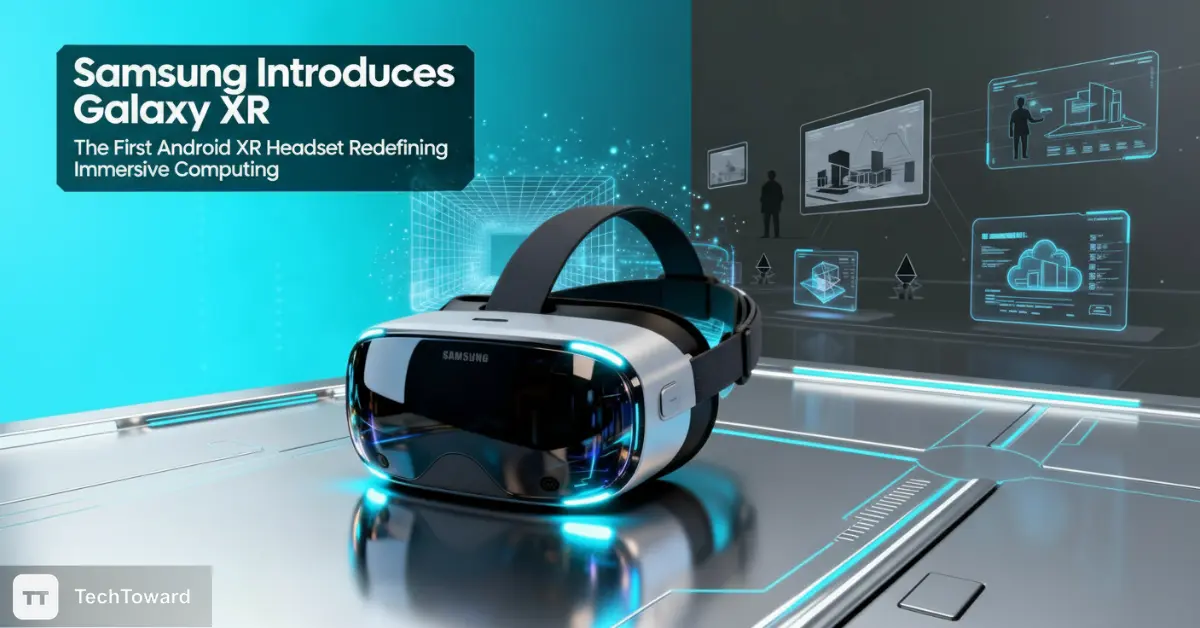Summary
The Samsung Galaxy XR, the first headset built on the new Android XR platform, may seem like a leap into complex territory, but with the right overview you can grasp how it opens up immersive computing in a surprisingly accessible way.
What is the Galaxy XR? (Basic Explanation)
Think of a headset that blends both virtual worlds and your real surroundings—this is what the Galaxy XR offers. In simple terms:
- It’s an extended reality (XR) headset — meaning it unifies augmented reality (AR) and virtual reality (VR) functions—so you can be immersed in digital content and stay aware of the physical space.
- It runs on Android XR, a platform recently developed for XR-devices.
- Key hardware highlights: a high-resolution display system, advanced hand/eye/voice tracking, a dedicated battery pack to reduce head weight, and premium optics and ergonomics.
If you’ve ever used a VR headset for gaming or seen AR on your smartphone (for example visual overlays on the camera), the Galaxy XR is the next step: making immersive computing an everyday tool, not just a novelty.
Why Galaxy XR Matters?
The platform shift: Android XR
- Android XR rethinks how we use software in spatial computing: it’s designed for headsets and glasses rather than just phones or tablets.
- Because it’s built with hardware partners, the platform promises tighter integration of AI, gesture/voice/eye inputs, and spatial awareness.
- For users this means: familiar apps may work naturally in a 3D space, developers have new opportunities, and companies can build ecosystems around these immersive devices.
Competitive positioning
- Galaxy XR enters the market at a significantly lower cost than some premium rivals, positioning it as more accessible for mainstream users.
- Because it comes from a large OEM with wide consumer reach and multiple device categories, it signals that XR may no longer remain a niche specialty—it could move toward everyday use.
- For enterprise and professional users, the headset opens new workflows: spatial dashboards, remote collaboration, immersive training, mixed-reality design.
Use-cases beyond gaming
- Entertainment & media: Think of watching a massive virtual screen, playing spatial games, exploring immersive environments.
- Productivity & work: Visualising 3D models, multitasking with multiple floating windows, remote collaboration within shared virtual spaces.
- Mixed-reality interaction: You can overlay digital items onto your real room, work while still being aware of your surroundings, or switch to full virtual immersion.
Design & comfort
- A modern headset must address comfort—how long you can wear it, how heavy it is, how natural the controls feel. The Galaxy XR emphasises ergonomics: balanced frame, detachable accessory (battery pack), light-shield optionally removed for mixed-mode.
- Interaction: Being able to use hands, eyes and voice helps reduce reliance on controllers and makes the experience more natural. This is key for broader adoption.
How to Use Galaxy XR: Step-by-Step Guide
Whether you’re a tech enthusiast or just curious, here’s how you’d get started:
- Unbox and charge
- Charge the external battery pack fully.
- Connect the headset with the pack if required.
- Make sure any initial software update is applied.
- Charge the external battery pack fully.
- Fit the headset
- Adjust head strap and back strap for balanced weight distribution.
- Attach or remove the light shield depending on your environment (immersed vs. passthrough mode).
- Put the headset on and adjust lens alignment (where applicable) and ensure visual clarity.
- Adjust head strap and back strap for balanced weight distribution.
- Initial setup
- Power the headset on.
- Sign into your account (if required).
- Go through calibration for hand tracking and eye-tracking.
- Define your physical play/working area: mark safe boundaries if you’ll move around.
- Power the headset on.
- Explore apps & interface
- Use voice or gesture to bring up the home interface.
- Launch familiar apps: watch videos, open immersive mode of your favourite mobile app.
- Switch between full-virtual mode and pass-through/mixed mode to see how it blends with your real environment.
- Use voice or gesture to bring up the home interface.
- Work, play, repeat
- For productivity: open virtual displays, place windows around you, reference documents while still able to see your desk.
- For entertainment: strap in for a game or immersive movie and enjoy the scale and sound.
- For mixed-reality: overlay digital objects in your room, collaborate virtually, walk around a virtual model.
- For productivity: open virtual displays, place windows around you, reference documents while still able to see your desk.
- Battery & maintenance
- Typical usage time is around 2–2.5 hours for more intensive immersive sessions.
- Turn off and disconnect battery when idle. Store the headset and battery in a safe and moderate environment.
- Clean lenses and surfaces regularly for best clarity and hygiene.
- Typical usage time is around 2–2.5 hours for more intensive immersive sessions.
Real-Life Example / Anecdote
Let’s imagine the experience of Maya, a product designer in Karachi:
Maya starts her day by picking up the Galaxy XR. She straps on the headset and places it on her head, the lightweight frame making it comfortable. She opens a 3D model of the furniture she’s designing—floating next to her real workspace. She uses her gaze to spin the model, her hand to resize parts, and her voice to say “show in daylight” and the environment shifts. Later she joins a remote meeting: her colleagues appear as avatars and they collectively work on the same model in virtual space while Maya still sees her real desk via passthrough mode. After a long but productive session (about 2 hours), she removes the headset, feeling she genuinely achieved more — not just played with a gadget. The comfort and integration into her workflow were seamless enough that she’s ready for the next session, confident this is more than just a toy.
Pros & Cons (Quick Comparison)
Here’s a table summarising strong points and considerations with this headset:
| ✅ Pros | ❌ Cons / Considerations |
| First device built on Android XR – fresh platform | Price still high for many consumers |
| Strong hardware specs and premium display/audio | Battery life (2-2.5 hours) may limit full-day use |
| Familiar Android apps can work in XR space | XR ecosystem still developing — fewer optimized apps |
| Natural interaction via hand, voice, eye tracking | Comfort and weight vary by user; headsets still heavier than glasses |
| Positioned for both consumer and enterprise use | Being first-generation, there may be early-adopter software quirks |
Who Should Consider Galaxy XR?
- Tech enthusiasts and early adopters who want to be ahead in spatial computing and immersive media.
- Professionals (designers, architects, remote teams) who can benefit from 3D modelling, virtual collaboration and mixed-reality workflows.
- Content consumers who want an elevated experience for gaming, movies, large virtual displays or new forms of interaction.
- Enterprise/education users looking for immersive training, simulation, remote collaboration tools.
If your main usage is simply watching videos on a phone or occasional low-intensity VR, then this headset may be more capability than you need—and you might be better with a more moderate or specialised device
FAQs (Commonly Asked Questions)
Q: What operating system does Galaxy XR run?
Short answer: It runs on Android XR.
This is the new version of Android built specifically for XR-headsets and glasses, optimised for spatial computing and multimodal interaction.
Q: When was the Galaxy XR launched and what is the pricing?
Short answer: The device was announced in late October 2025 and is priced around US $1,799 for the base headset.
Regional pricing and availability may vary.
Q: What hardware specs are noteworthy?
Short answer: High-resolution micro-OLED displays, advanced tracking (hand, eye, voice), dedicated battery pack, next-gen chipset (e.g., Snapdragon XR2+ Gen 2), ergonomic design.
These specs are at the high end of XR hardware.
Q: Can I use my regular Android apps on it?
Short answer: Yes — many existing Android apps can run on the device, and the platform is compatible out-of-the-box with mobile apps.
However, truly immersive or spatial-UI optimised versions may still be emerging.
Q: How long does the battery last and is it comfortable for long sessions?
Short answer: Battery runtime is about 2–2.5 hours for immersive usage.
Comfort is improved via lighter weight and ergonomic design, but as with any head‐mounted display, individual tolerance will vary.
Q: Is this device only for entertainment/gaming?
Short answer: No — the design supports discovery, work and play.
Use-cases include training, virtual collaboration, spatial visualisation as well as games and media consumption.
Conclusion
In summary, the Samsung Galaxy XR represents a compelling leap in immersive computing: merging a cutting-edge hardware design, a dedicated platform (Android XR), and natural user interactions via voice, hands and eyes. For anyone seeking to explore beyond conventional screens and devices, it offers a strong choice.
If you’re ready to step into the next era of digital experience—whether for creative work, better entertainment, or game-changing productivity—consider booking a demo or pre-order of the Galaxy XR today. It’s time to be part of the XR wave with confidence.


